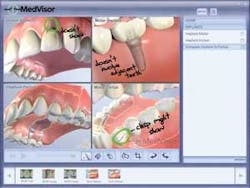Rx for GROWTH in 2006
Using imaging to increase case acceptance can optimize your time, talent, and results.
Why is it that some dentists can see fewer patients and produce more dollars? Why do some dentists attract patients who need extensive care while others claim their patients need very little treatment? Why do patients who need extensive treatment accept it from one dentist but merely accept treatment for their perceived immediate concerns from another dentist?
All of these questions can be answered by looking at three vital signs: doctor’s awareness, patient’s awareness, and doctor’s assumptions.
Many practitioners believe that practice growth is dependent on new patients. I agree new patients are necessary; however, in most practices, the lion’s share of growth stagnates within the filing cabinet.
Let’s examine the vital signs mentioned previously:
1) Doctor’s awareness - This principle serves as the bedrock to a doctor’s practice. In fact, most growth in a doctor’s practice will be leveraged off this core concept. Doctor awareness is identifying what you believe is the best dentistry you can do for your patient. So many times this judgment gets clouded by benefit plans, assumptions we make, and lack of support from the team. In order for you to experience the growth potential of your practice this year, you must first clarify your clinical vision. Get back down to core beliefs you have - before benefit plans got you sidetracked from ideal care. What do you believe is the best treatment of choice? What do you consider optimal care? What would you do for your family member?
Once you’re clear on the above answers, you’ll have to be aware of who on your team buys in to that vision and who does not. While you are the primary force in your office to make your clinical vision a reality, it will take a true team to implement it. Everyone on the team needs to share in those core beliefs and employ them to assist patients to balance their needs and desires with your best treatment choices. Be committed to devoting the time needed to educate your team to the benefits of ideal dentistry; it takes a team effort to raise the patient’s awareness for ideal dental treatment.
As in any change process, things may get a little bumpy as you move through implementation. It is imperative to keep the team focused on the long-term win for patients (and ultimately your practice) when patients receive what they truly desire. You will be happier pursuing the type of dentistry you want to be doing, and happier patients will refer additional patients.
2)Patient’s awareness - Do your patients truly understand the current situation in their mouths? Do they understand why they’re the way they are? The process of raising awareness begins with the new-patient exam and continues throughout the relationship in your office. Whether the new patient is seen in hygiene or the restorative schedule, they must understand there are three areas of the mouth that are evaluated each time:
✔ Perio
✔ Function
✔ Esthetics
As clinicians, we go to great lengths to collect and document the above data; however, we may neglect the most important aspect - communicating that data to the patient in such a way to make it clear why the problems exist. We can talk clinically until we are blue in the face, when all we really need to do is remember the old adage, “One picture is worth a thousand words.” Imaging is our answer.
These imaging tools can be as simple as written brochures and educational videos, or as elaborate as my digital imaging Smile Design Galleries and the exciting new interactive MedVisor patient education system. I’ve used the intraoral camera since 1988. Today, I coordinate all of these tools to maximize my patient’s awareness and to accept the best treatment that I can offer.
These imaging tools allow you to be thorough in your explanation of the periodontal, restorative, and esthetic conditions of the mouth in layman’s terms, why they exist, and how you will treat the situation. Imaging allows you to show wear patterns, facets, conditions of existing fillings and restorations, and the condition of the remaining tooth structure. The animated images of MedVisor allows you to explain what caused the situation and then explain the options that optimal dentistry provides. Your patients then have the opportunity to choose the best options based upon a complete understanding of problems and solutions.
Imaging raises the patient’s awareness of the possibilities of cosmetics and smile enhancement like never before. When patients visualize the potential improvements to their smiles, that first step toward achieving it becomes a lot easier. Imaging offers the clinician a better understanding of what the patient may be asking for, in addition to creating a concrete image of what the patient may be seeing with his or her mind’s eye. You need to be aware of committing to unreasonable expectations or undoable results. Imaging assists both the patient and the doctor in understanding the achievable as well as the desirable end results.
Imaging technology offers a win-win situation for your patient and your practice. Both parties are empowered when the treatment options you present agree with your clinical vision and, most significantly, what is important to your patient.
3)Doctor’s assumptions - Too often I see clinicians make assumptions about their patients’ desires, wants, and perceived needs. We get into trouble when we presume to take away our patients’ rights and abilities in order to choose what’s best for them. Just as we believe it is not the patient’s benefit plan that should choose or limit the proper treatment, neither should we dictate the treatment or assume the patient can’t afford it. It is, however, our responsibility and duty to inform patients of the very best that dentistry offers. It is our patients’ obligation to their own dental health that will ultimately determine their course of treatment acceptance.
In order to put your own assumptions as well as your team’s assumptions to rest, you must learn to start asking and stop assuming. This could be the biggest pill you’ll have to swallow, but it will have the largest impact on your growth this year.
Patients begin to consider the possibilities when -
▲ They are given the opportunity to openly discuss what they think of their smiles
▲ They are encouraged to think about the things they would change if they could and how it would impact their daily lives
▲ They have been adequately informed of all the treatment options.
Practice growth is achieved when you focus on your patient’s desires and what you believe is best for your patient, not what may be most easily accepted.
When I work with dentists, I often hear the objection that case presentation feels like selling. Done properly, case presentation is a process of problem solving and empowerment. Time and again the doctors find that by using imaging, the process takes on the tone of a partnership, not a sale. Having well-defined practice goals shared by your team and eliminating preconceptions, you have the opportunity to achieve your ideal practice of optimized patient care through imaging and delivery.
What better way to start off 2006 than by clarifying your vision for your practice and the dentistry you want to do - and then doing it? You might help a patient achieve his or her dream in the process.
Elizabeth M. Iverson is a speaker as well as a coach. Her diagnostic prescriptive approach is unique among coaches because of her depth of experience and education in business, dentistry, and the business of dentistry. As the Dental Doctor, she creates better business development through leadership, communication, and team building. For further information on available services, contact the Practice Leadership Center at (800) 665-LEAD, or e-mail [email protected].


